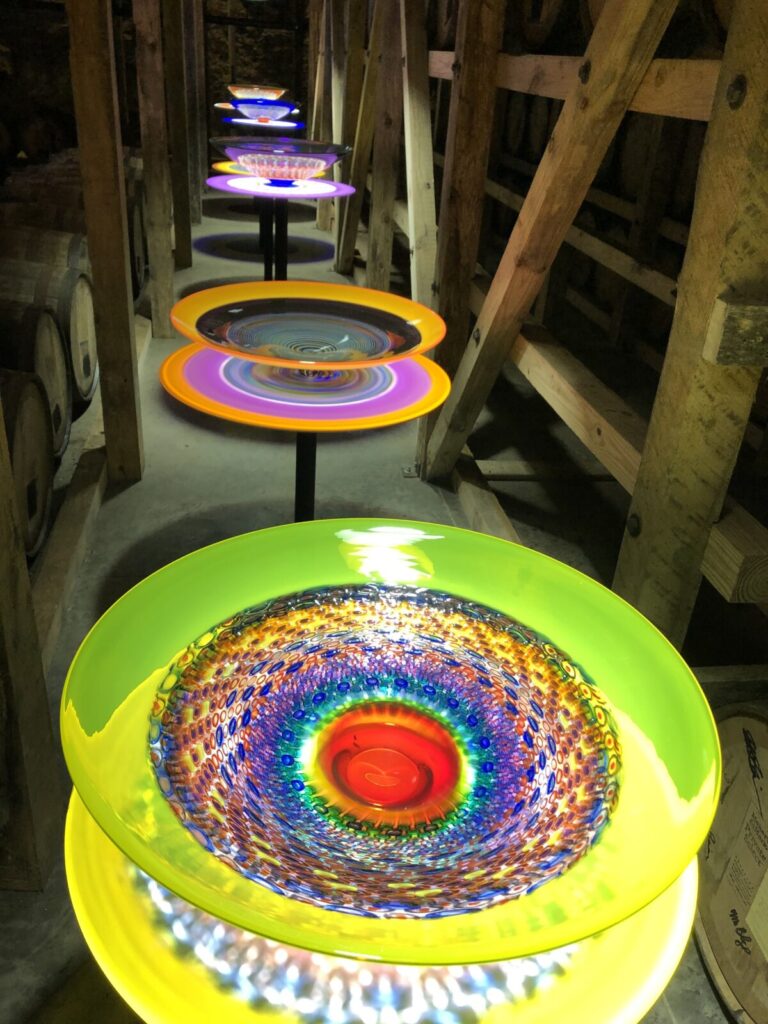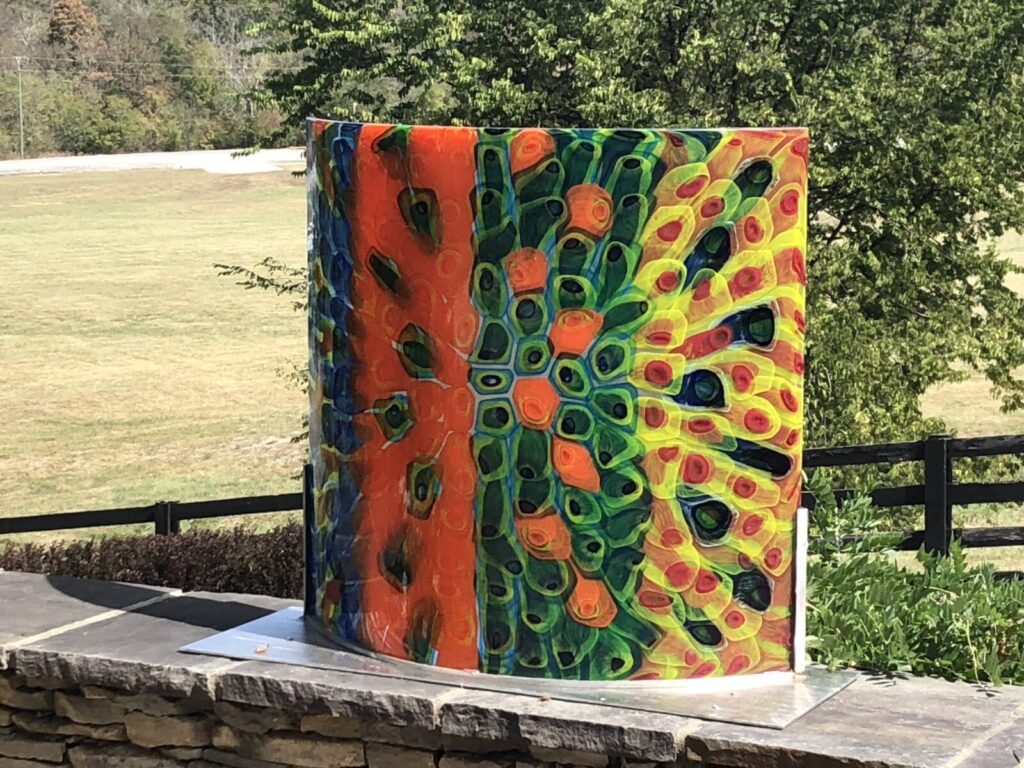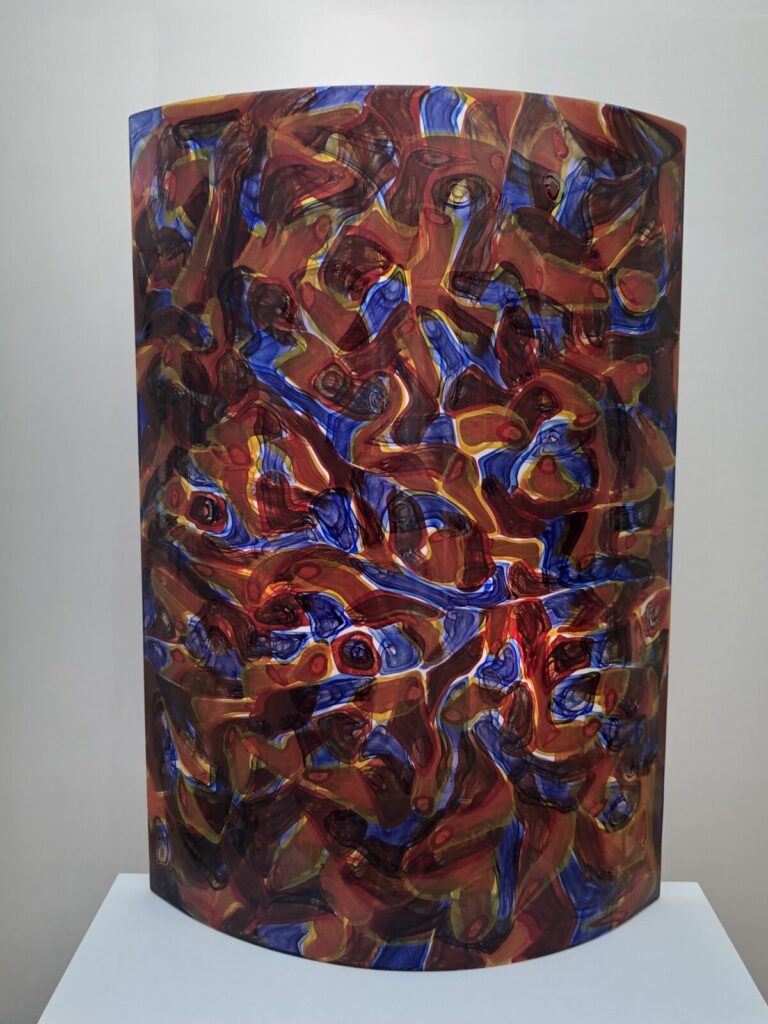Centre College professor Steve Powell had an extraordinary range of devotions – to his family, to his art, to his students, to a wide circle of friends, to his craft, to his sense of fun and, perhaps, to a sheerly extravagant expenditure of energy for its own sake. One winter he planted 20,000 saplings around his hilltop home. On another occasion he trucked in 150 tons of sand to create a beach on a small Kentucky pond. It was way too small for jet-skis, but short-tracking around the pond happened anyway, and in one legendary instance, a jet-ski and rider departed from the water and careened across the ground. Friends recall that Powell read many books, but only the first 100 pages – impatience caught up with him. Powell transformed a sizable former Coca-Cola bottling plant into an office and studio, indoor basketball half-court, pool hall, archive of Coke memorabilia, a gallery and hot shop for glass art, a shower with nine hand-blown glass nozzles, and a setting for his nine-piece set of drums. His death on March 16th of this year deprives Kentucky of one of its most talented artists and most vivid and beloved personalities, a man with a genius for wholeheartedly giving of himself.

At a memorial service at Centre College on September 21st and in a video by Pam Powell, Steve’s sister, speaker after speaker attested to the sense of privilege felt by everyone around the sculptor – colleagues, students, friends, family and fellow tennis and poker players.
For Powell student and University of Louisville glass professor Ché Rhodes, Powell’s greatest contribution to his students’ development was “his inability to see impossibility,†and for Father Norman Fischer, “it was allowing his students to soar.†For Stephen Cox, “in the most basic form, we were family and we were friends, which in itself, being separated by more than three decades in age, is a testament to Steve’s ability to remain fresh in almost every aspect of the word.â€
Stephen Powell was born in Birmingham, Alabama, on November 26, 1951. His mother, Anne Hettrick Powell, was active in cultural and civic organizations, a university administrator and a lifelong member of Birmingham’s Episcopalian Church of the Advent, a downtown parish in the forefront of support for civil rights in the 1960s. His father was Arnold Francis Powell, playwright, chair of the Speech and Drama Department at Birmingham Southern College for 31 years, and a powerful force in Southeastern theater. There are many parallels between father and son: both were dedicated to the avant-garde, both excelled at fostering creative ensembles, both were extremely industrious, both returned to their alma maters to teach, and both were adulated by their students. Arnold Powell, nicknamed “Dr. God†by drama majors, eventually ran afoul of his college’s administration, which admonished him to eschew the cutting edge plays he favored, and to place “less emphasis in future on violence, sex and gutter language.â€Â A breaking point came to the traditionally Methodist liberal arts college when, in a production of Tom Stoppard’s Jumpers, an undergraduate actress appeared in her underwear. “I was called down for it,†retorted the senior Powell, “but in the original she’s supposed to be nude.† The college denied it had exercised censorship, but Arnold Francis Powell successfully sued the college for wrongful termination.
I wrote an essay for the catalogue of the 2012 retrospective exhibition of Powell’s art, “Psychedelic Mania: Stephen Rolfe Powell’s Dance with Glass†at the Montgomery Museum of Art. My essay was entitled Wittgenstein, the Allman Brothers and the Countercultural South: Reflections on the Art of Stephen Powell.  I took off from philosopher Ludwig Wittgenstein’ very readable set of musings, “Remarks on Colour,†essentially making the point that color defies any ordered system of logic. Beyond an obsession with color, I described the musicality of Powell’s art, the athleticism and similarity to performance art in its making, its theatricality, dependence on chance, and its counterculture re-casting of Southern masculine identity. Steve was polite enough to not tell me I was full of it.

Stephen Powell displayed an Alabaman’s dedication to the Crimson Tide and to Southern traditions of gentlemanly courtesy and hospitality, and to restorative justice: in lieu of wedding presents, Steve and Shelly asked guests to make a donation to the Southern Poverty Law Center. Heritage, too, played a part in his musical tastes, which were widely eclectic, but favored “road scholars,†southern country rock practitioners like the Allman Brothers Band, whose music was deprecated as “swamp music†when it first came to public notice in the late 1960s. Fueled by dual drummers and twin lead guitars, the Allman Brothers’ hard-driving rock provided a sound track for many glass blowing sessions, but more particularly its percussive rhythms seem an apt metaphor for the pulsating rhythms Powell achieved with globules of vivid colors – yellow, orange, and violet, for example – playing against sub-units of blues and greens, with smaller dashes providing a syncopated counterpoint of mauve ovals, and sunbursts of purple: Powell played with variations of slow to fast tempos, a wide chromatic scale, and polyphonic harmonics across the spectrum.
Powell’s art was a continuous drive to discover heightened means to ever more enrapturing, effulgent experiences of color. His drive was to transform light into color, color into light, as if it his works were colored atmosphere and solid simultaneously. Color and form are inseparable in Powell’s very personal language of abstraction. His artistic evolution was a virtuous circle of invention and technical expertise feeding artistic expression, in turn fostering additional craftsmanly and technical exploration. His five major series of glass forms – Teasers, Whackos, Screamers, Echoes and Zoomers – all challenge the limits of their medium, and are genuinely innovative as glass, but perhaps have been mistakenly pigeon-holed solely as glass art. Powell was foremost an abstract sculptor concerned with color and movement: his delightfully individual and eccentric inventions of compelling formats for a rhapsodic experience of color may be his lasting contribution.

Powell’s last series were called Zoomers – panels of glass often curved to be free-standing. Described as an enlarged version of the murrini of colored glass in earlier work, the Zoomers are sheer chromatic energy, great bursts and spiral novae of color. The play of order versus chaos, so much a part of Powell’s process, is alive in these works. They evoke life at its most elemental, amoebic level.
[aesop_video src=”vimeo” id=”362996000″ width=”85″ align=”center” disable_for_mobile=”on” loop=”on” controls=”on” mute=”off” autoplay=”on” viewstart=”on” viewend=”on” revealfx=”off” overlay_revealfx=”off”]
A survey of Stephen Powell’s works is on view at Maker’s Mark Distillery. His pieces hold their own in the redolent, angel’s envy-rich environment of bourbon aging warehouses. But best of all is a Zoomer outdoors, mediating between the viewer and the landscape beyond.
Current exhibitions celebrating the life and work of Stephen Powell and his students are as follows:
“Stephen Rolfe Powell ’74: A Retrospective,†AEGON Gallery, Jones Visual Art Center, Centre College, Danville, Kentucky, through October 12th.
“Through the Eyes of the Maker: Stephen Rolfe Powell,†Maker’s Mark Distillery, Loretto, Kentucky, through November 30th.
“Legacy: The Assistants of Stephen Rolfe Powell,†Flame Run Gallery, 815 West Market Street, Louisville, Ky., through October 25th.




